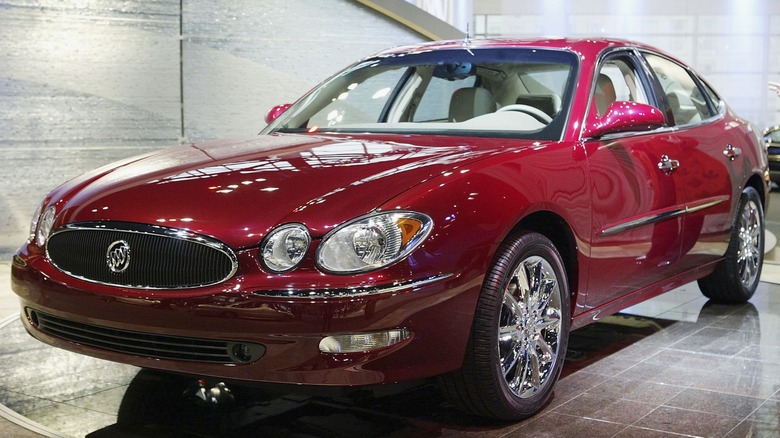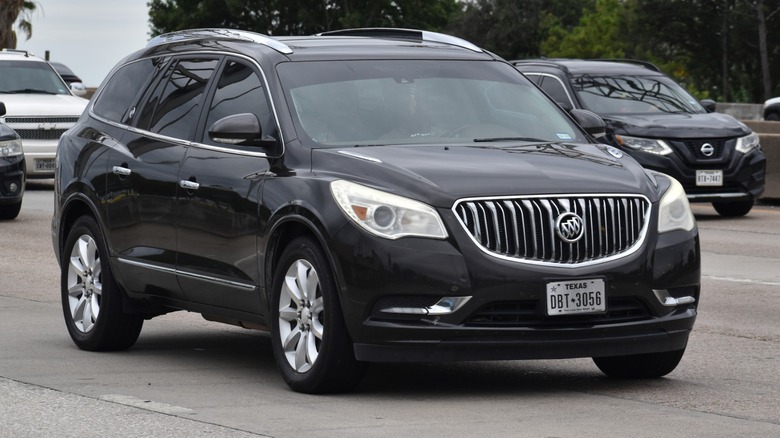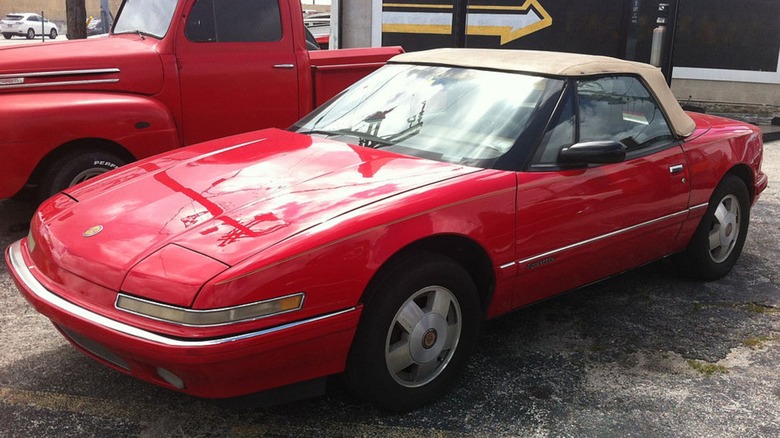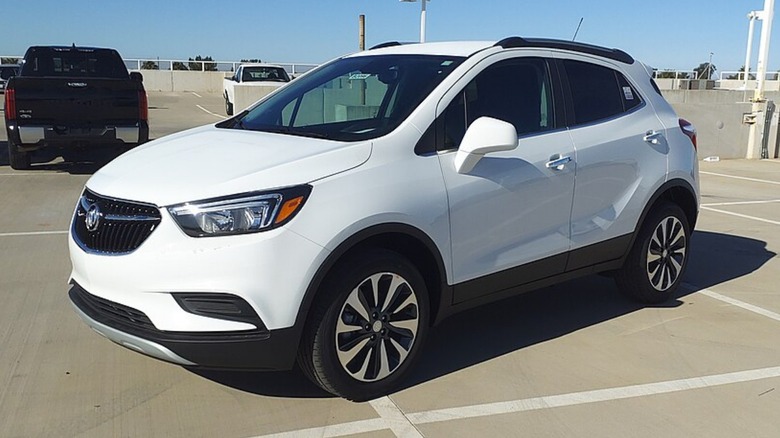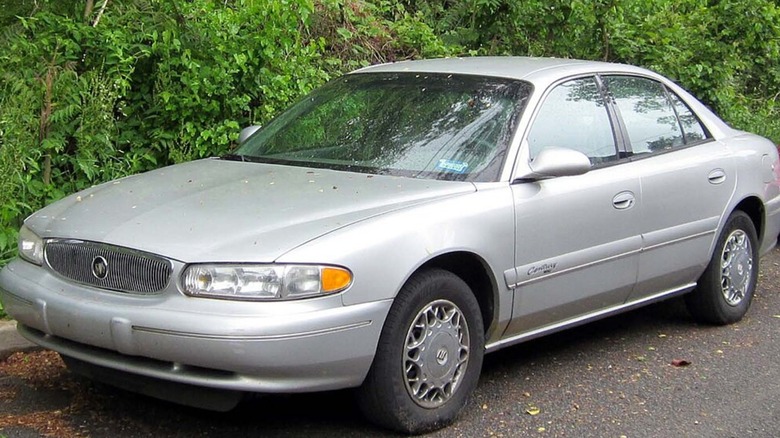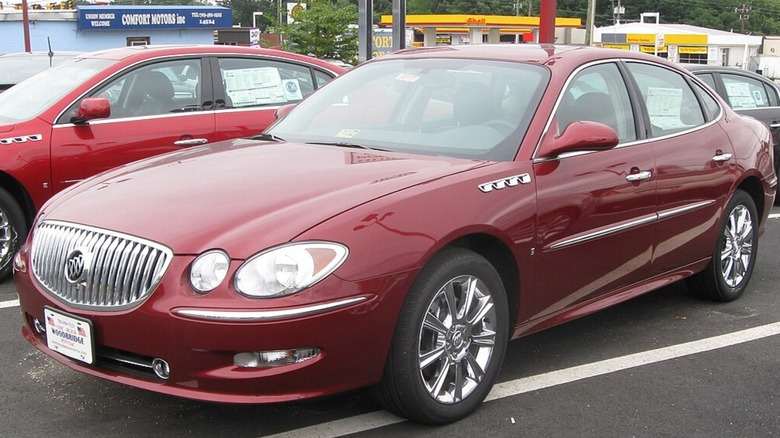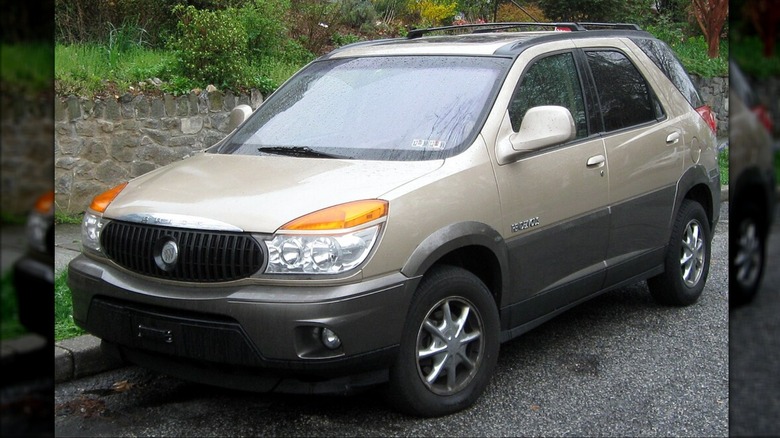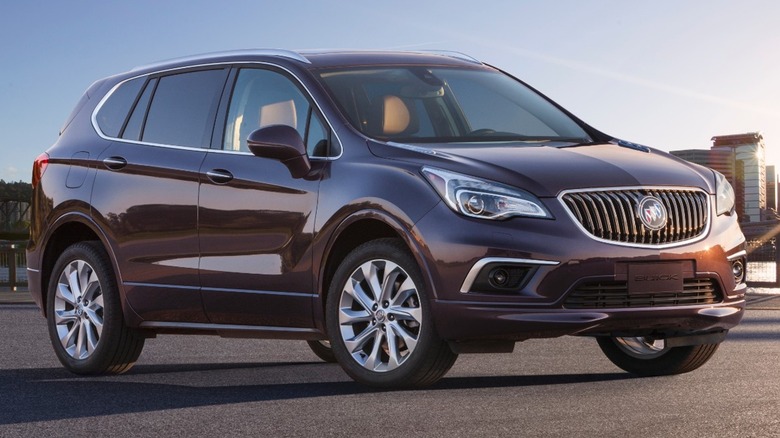7 Used Buick Models You Should Steer Clear Of At All Costs
As one of the oldest existing automobile manufacturer in America, Buick has a long and storied history. Initially founded as an engine manufacturer, Buick Motor Co. was established in 1903, quickly ramping up production to become a leading brand. It also served as the cornerstone division of General Motors upon its foundation in 1908 before being joined by Chevrolet, Pontiac, Oldsmobile, and Cadillac over the next couple of decades.
In the decades between then and now, Buick has built a multitude of automobiles, always offering buyers upscale cars offering premium appointments with pricing just below cars that reach luxury status. Buick has always been the brand for customers who can afford the nicer things but lack either the desire or ability to acquire the most extravagant cars on the market.
As a division of GM, Buick has always had a part to play within its market segment, although equipment and technology are shared across the company's divisions. This means its cars are generally reliable and well-built while a selection of past models stand out for innovation in technology, luxury, and occasionally performance, such as the legendary turbocharged V6 Buick Grand National muscle car of the '80s.
However, like any other auto manufacturer, some Buicks miss the mark and stand as failures or disappointments for one reason or another. This could be the result of poorly executed innovations, inconsistent quality control, or inexplicable design choices. Therefore, for various combinations of these reasons and more, these six Buicks are models you would do well to avoid.
Buick Enclave 2008-2017
While Buick was known for decades as a purveyor of comfortable and classy cars, the modern era brought with it a need to have SUVs available across the lineup. This trend has continued to the point that most U.S. automakers don't sell sedans at all anymore, including Buick. In 2008, Buick introduced the Enclave to replace two prior SUV models based on a truck and a minivan platform with a dedicated SUV unibody platform.
One selling point of early Enclaves was the generous output of its 3.6-liter V6 engine, 275 horsepower. The High Feature V6, as it was called by GM, featured 24 valves driven by overhead cams with variable valve timing. Although it provided good power with smooth delivery while running quietly, far too many owners experienced issues with stretched timing chains. Early indicators of this problem can manifest as light ticking sounds, but it becomes evident when the check engine light returns multiple trouble codes from a scan.
Unfortunately for far too many owners, the timing chain repair is an extensive process requiring a skilled technician and lots of time. It can cost a couple of thousand dollars to fix, but if it is left to fester too long, it can go much higher. Poor maintenance contributes to this issue, making buying a used Enclave a gamble, especially since transmission issues are also much too common. Without thorough service records from a meticulous previous owner, a used Enclave is best left on the lot.
Buick Reatta 1988-1991
Long hailed for its classy sedans and the occasional sporty coupe, Buick had always made cars with seating for at least four occupants. While the '80s saw it producing a mix of exceedingly dull and lumbering sedans, the shot of adrenaline from cars powered by the Buick 3.8-liter turbocharged V6 engine helped raise its sporting image.
Dubbed the Reatta, this new Buick sports car for 1988 sat apart from the rest of the lineup for being a fun and impractical car built for the sole purpose of driving enjoyment but with typical Buick refinement. While it broadly sparked interest and received praise in the press, its high price kept droves of buyers from the showrooms. Furthermore, while it was sporty, performance was not its forte.
Driven by the venerable and endlessly reliable 3800 V6, Reattas are not known for being particularly problematic. However, these cars did come with advanced electronics throughout, including a forward-thinking touchscreen system using a CRT display and 1980s computer technology behind it. As these cars reach beyond 30 years of age, those electronics can be problematic. While you won't find them listed with many modern consumer guides, anecdotal evidence from a variety of forums points to troubles dedicated owners may have in keeping Reattas in top condition.
The idea here is not that a Reatta is a particularly bad purchase — it just might be a bad purchase for someone not ready to dive deep into keeping it going themselves.
Buick Encore 2012-2022
After establishing itself solidly in the SUV market with its Enclave, Buick followed up in 2012 with the smaller Encore crossover. Sitting on a subcompact platform, the Encore is petite but still well-equipped. It proved to be a good choice for the automaker as sales took off right away, continuing as part of the lineup until it was replaced by the Envista, although a larger Encore GX was added in 2020 and remains available today.
As a subcompact model, the Encore's motivation comes from a small 1.4-liter four-cylinder engine. To squeeze power and efficiency from the little power plant as all automakers have done recently, GM installed a turbocharger to its Ecotec engine, making it good for 138 horsepower in the Encore. It still is not a huge amount of power for this 3,200 pound car, which means acceleration is mediocre. However, acceleration will surely become much worse should the turbocharger fail, and that is known to happen.
Turbocharger failures plagued many early Encores and engines had to be replaced after owners experienced poor acceleration, stalling, and oil smoke. Furthermore, the Encore is subject to many recalls, including several pertaining to a failure of airbags to deploy and one recall stating the steering wheel could fall off. The Encore is an attractive little car, and Buick puts nice touches on the interior, but perhaps it may be a good idea to check elsewhere if one pops up in your used car search.
Buick Century 1997-2005
In 1936, Buick released a car it called Century. For the day, it was a runner. Using one of its smaller chassis, Buick stuffed its largest eight-cylinder engine, a 320 straight-eight, under the long, skinny hood to produce a simple but elegant car that outpaced most cars on the road of its day. While a multitude of changes came and went over the years, the Century name remained with Buick all the way until its 2005 retirement.
The final generation of Century was produced from 1997 until 2005. Many of these cars are still on the road, but none of them have ever been described as runners nor elegant. They were the basic Buick sedan bought by customers who wanted simple Buick comfort with no regard to style or performance. Of all the Buicks of the era, the Century was perhaps the most bland and uninspired, inside and out. It was a car for people who did not think much of driving cars in general.
If the general lack of style and overall malaise of the final Century is not enough of a reason to avoid it, the intake gasket leaks, which end up mixing coolant throughout the engine, should be. Once again, with the car out of production nearly two decades, relevant user reviews and buying guides are scarce. However, anecdotal stories found online complain of incessant intake leaks on the 3.1-liter V6 plaguing this car. Furthermore, YouTuber Car Wizard puts it on his definitive list of Buicks not to buy for the same reason.
Buick LaCrosse 2005-2009
After retiring two of Buick's long-running nameplates – Regal and Century — the company introduced its new LaCrosse as the standard-bearer for affordable luxury from a domestic brand. It was built from the start with an eye on having a refined, comfortable, and supple ride while surrounding passengers in quiet and comfortable surroundings. Its styling stayed well within reasonableness with preferences for conservative design that won't ruffle the feathers of, well, anyone.
While standing out as an improvement in looks over the outgoing Century, the LaCrosse remained stuck in the uninspired wing of Buick design language. Despite this, performance was lively as the 3.6-liter V6 offered in some variants provided over 250 horsepower. Even better, a sleeper LaCrosse Super also showed up with a transversely-mounted 5.3-liter LS V8 with more than 300 horsepower. That car is a great choice and should be procured immediately if ever found in the wild. However, the 3.6 should be avoided.
Particularly in 2010 and 2011 models, timing chains on the High Feature V6 are prone to stretching, resulting in extraordinarily expensive repairs. As these cars are now approaching 15 years of age, those repair costs can quickly surpass the price of the whole car –- assuming car prices ever return to sane levels. So the advice here is to avoid certain years of the LaCrosse, but buy any V8 model you find immediately.
Buick Rendezvous 2002-2007
The GM U-platform developed in the early '90s underpinned a new wave of car-like minivans across its motor division, although Buick was initially left out. However, as the popularity of the SUV exploded and manufacturers began offering SUVs built on automobile chassis instead of a truck frame, Buick adapted the U minivan platform into its first crossover SUV, the Rendezvous.
Debuting for the 2002 model year, the Rendezvous sat tall and offered a spacious interior with power delivered by a 3.4-liter V6 and optional all-wheel-drive. Styling took cues from existing Buicks, which is to say designers took a typical conservative approach to the exterior and filled the interior with premium materials and options. You might say this vehicle is not the most attractive, nor is it particularly ugly. It certainly could be worse when you realize it is a badge-engineered version of the Pontiac Aztek, a feature-rich car that is widely panned for being so hideous.
While having avoided being hit with an ugly stick, the Rendezvous remains undesirable for being underpowered, having cheap plastic interior parts, and driving like a minivan without the room or convenience they offer. The engine powering this overly heavy car -– more than 4,000 pounds with AWD –- was outdated upon debut, and it is harsh and unrefined. Reports of transmission problems, intake leaks, fuel pump failures, and more also do not inspire confidence. Simply put, even when considering its age, there are better choices on the used market.
Buick Envision 2024-2025
Not all buyers need advice on used vehicles to buy as they are in a position to purchase new, but they can still benefit from knowing which new models to avoid. Since Buick only offers four models in total at the time of writing, it can be tough to narrow that down unless one has already become notorious for glaring defects, and none have. So buyers drawn to the Buick brand may have a tough choice.
Currently Buick only offers the Envista, Encore GX, Envision, and Enclave. Furthermore, this is probably Buick's slimmest lineup of vehicles in decades, and they all look like slightly different variations of the same vehicle. The wide array of model designs seen in the '60s, 70s, and even into the '90s is gone, leaving you with choosing a new Buick solely on the nuanced differences between the models. Of these, the Envision is one to avoid.
The Envision falls short of its competition on several fronts. Although it comes packed with GM's best available features, including SuperCruise since 2024, the interior fails to meet its luxury aspirations and the handling feels underdeveloped, according to Car and Driver. Reviewers at Motor Trend also notes vague steering and a lack of power from an unrefined powertrain. Additionally, Edmunds consumer reviews give it a 3.8 of five stars while its official review claims it to be unpolished, recommending that consumers take a look at the Mazda CX-50 or Volkswagen Tiguan for less money.
